How Lithuania fast-tracked green procurement

Challenge: In 2020, only 5% of Lithuania’s public procurement spending by value used green criteria that favor environmentally friendly products and services. The government wanted to shift that to 100% by 2023.
Approach: Lithuania launched an ambitious public procurement reform in 2021 to reduce the country’s carbon footprint and ensure every public procurement decision considers its environmental impact. The government took three key steps:
i) careful planning for the green transition;
ii) implementing green public procurement (GPP) in practice with a focus on building the capacity of public buyers; and
iii) learning powered by data-driven monitoring with a public dashboard.
Results: Levels of green procurement uptake across Lithuanian public institutions have increased to 94% by value and 93% by total procedures as of 1 December 2023. The Government is now moving beyond measuring outputs like the use of green criteria to focus on the outcomes from better procurement, such as reducing Lithuania’s carbon footprint, working with OCP and Kaunas Technology University. It is currently developing a methodology to calculate the impact of green public procurement on CO2 emissions in high-carbon sectors such as energy and transport and specific products such as paper.
The reformers share their top tips on implementing green procurement here.
If you catch a bus in the port town of Klaipeda, Lithuania, there’s a good chance it will be a ‘Dancer’. The electric bus is assembled locally and made with materials that include recycled PET plastic. Its lightweight construction means the vehicle uses less energy than its competitors and can run on smaller, fast-charging batteries.
The city government of Klaipeda runs the Dancer bus service through a comprehensive, 10-year lease agreement that is the first purchase of its kind in the country, a result of Lithuania’s shift to using green criteria for public contracts.
“We didn’t only procure buses, but a whole service package that includes delivering the buses, their full technical service and maintenance, constructing charging stations, and electricity supply and insurance,” Klaipeda municipality’s Director of Finance and Project Management Department, Elida Mantulovė, told local media when the service won an innovation award last year.
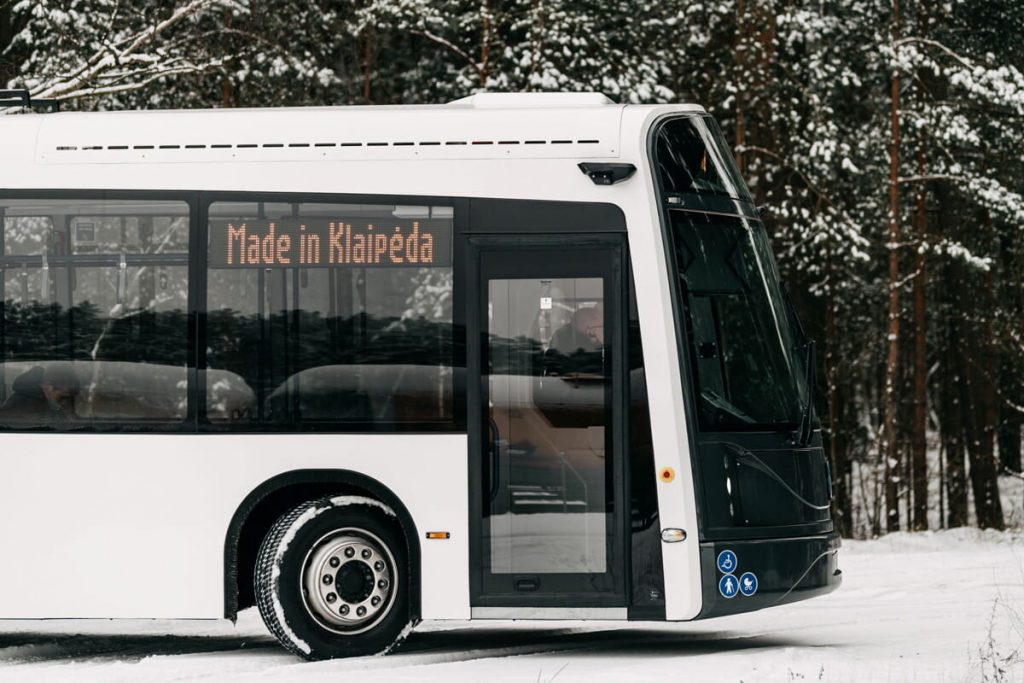
Klaipeda is far from the only public agency in Lithuania using innovative approaches to procurement to make its city greener and healthier.
Government buyers nationwide are making more environmentally friendly purchases following a major procurement reform that has seen the use of green criteria in contracting soar from 5% of the market by value in 2020 to 94% as of 1 December 2023.
Led by the LPPO and Ministry of Environment and Innovation, Lithuania launched the reform in 2021, boldly announcing their ambitious target of buying 100% green in less than three years by ministerial decree. Affecting around 4000 public buyers, the decree defines procurement as ‘green’ if it uses green criteria, recognized certificates, ecolabels or environmental management systems for no less than 50% of total procurement value.
“Public buyers have the freedom to use the green criteria either as part of technical specifications, selection or award criteria, through contract implementation and through supplier qualification, for example by requiring an environmental management system certificate,” says Darius Vedrickas, Director the LPPO.
The ministerial decree, along with other government-wide policies designed to develop the green economy and an environmentally friendly business culture in Lithuania, established a clear political commitment to drive action.
In addition, a dedicated Sustainable Public Procurement (SPP) Competence Center was established in the LPPO to lead implementation and to support contracting authorities and suppliers in their adoption of green criteria.
Open consultative approaches and the use of digital tools and open data have been critical to promoting and tracking the switch to sustainable procurements, as Kęstutis Kazulis, principal advisor for sustainable procurement to LPPO told us when we first wrote about the reform last year.
In 2023, the LPPO added a set of key sustainability performance indicators to its procurement dashboard.
A long-term action plan was also created, with milestones set for strengthening the legal mandate for green procurement, further professionalizing the process, and introducing new tools into the e-procurement system that will facilitate greener procurement choices by 2025.
The Open Contracting Partnership (OCP) is proud to have been a supporter and cheerleader for the reforms, facilitating dialogue between stakeholders, advising on data and benchmarks to publicly monitor the shift, and sharing the lessons learned globally. Skip ahead to read the top tips on implementing green procurement from Lithuania.
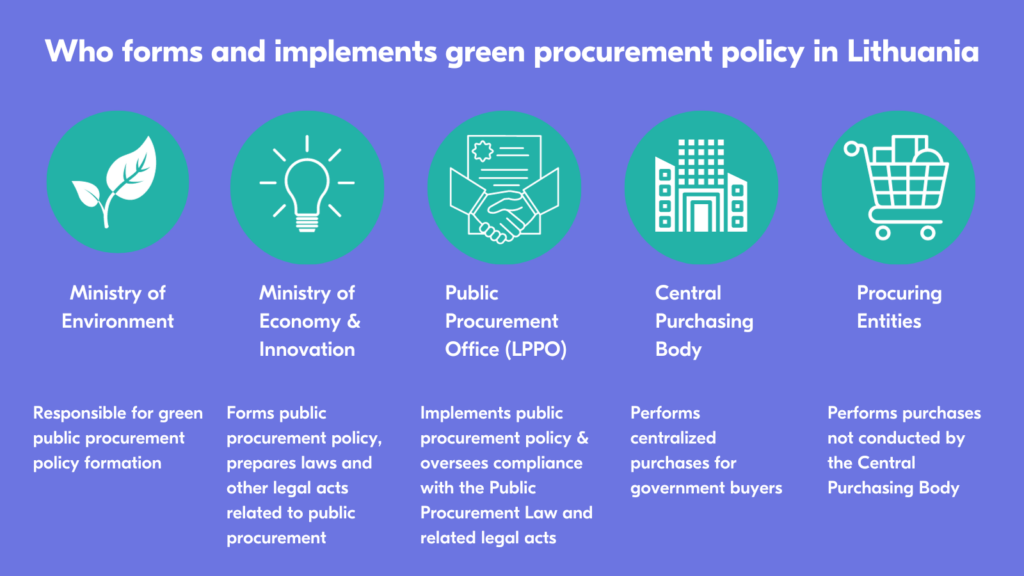
Can everything be green?
The SPP Competence Center team consists of six experts who advise policy-makers and contracting authorities on all aspects of green, socially responsible and innovative procurement. They also publish resources and run training sessions and other events to support vendors in transitioning to greener offerings and to promote procurement practices that are good for people and the planet, as described in their 2022 activities report.
The LPPO had to learn on the go about the challenges of using green criteria. How could the National Opera use green criteria to hire an orchestra conductor, for instance? Or how could buyers minimize the very real risk of greenwashing?
Since OCP’s first story about the reform, the government has developed an intelligent exceptions system to account for situations where applying green criteria is near impossible.
Introducing green criteria was always seen as the first step of the green transition, and an opportunity to understand where attention should go in subsequent phases of the reform. For instance, it raised issues such as how to mitigate the risk of greenwashing (tightening controls in the contract implementation phase could help with this) or how to ensure a balance between multiple performance metrics, particularly competition which tends to drop when green criteria are introduced (one measure to address this is allowing contracting authorities to use self-determined green criteria that are equivalent to the standard criteria set by the decree).
Erika Kurockina, the Deputy Minister of the Economy says: “Public procurement is certainly an effective tool to achieve strategic objectives, including SME engagement, inclusion, environment, and it is important to achieve a good balance between these goals. Making procurement green is not a goal in itself – it is only an effective instrument to contribute to the EU Green Deal, and it helps, but we also have to be mindful of other goals. For example, we see that GPP reform, while it was extremely ambitious, affected our competition negatively – it dropped by 6%. We now have to help our business adapt and innovate. We also have to help our buyers with capacity, always keeping an eye on the big prize – cleaner, better environment.“
Green flags
Based on insights from using green criteria, the LPPO has made improvements to the system to enable more granular analysis. Moving from monitoring general uptake levels (% of value and procedures), the recently launched new version of the dashboard can track much more than that.
It shows exactly what GPP criteria have been used most often and by which institutions. For example, in October 2023 (the most recent month for which there are complete statistics), the most used criteria were self-determined environmental criteria (52%), minimal environmental decree criteria (18%), and environmental management system criteria (15%).
“Self-determined environmental criteria” refers to criteria that contracting authorities establish themselves. These criteria have to be equivalent to those set by the ministerial decree, and they must be verifiable and traceable (such as official certification schemes or ecolabels).
“Minimal environmental decree criteria” are a list of criteria set by the ministerial decree for 18 product categories and heavily based on the European Commission recommended criteria.
“Environmental management system criteria” is a requirement for suppliers to have a management system that is environmentally friendly, certified by a third party.
You can see how green different procurement procedures are too. For example, in October 2023, 97.5% of simplified procurement procedures were green, 89.8% of small value procedures, and 100% of design contests.
The monitoring tool shows where exactly green criteria were used most often: contract clauses, followed by technical specifications, supplier requirements, qualification requirements, and award criteria.
Importantly, all previous procurement that used specific green criteria can be listed and accessed in the platform, enabling contracting authorities to learn from one another.
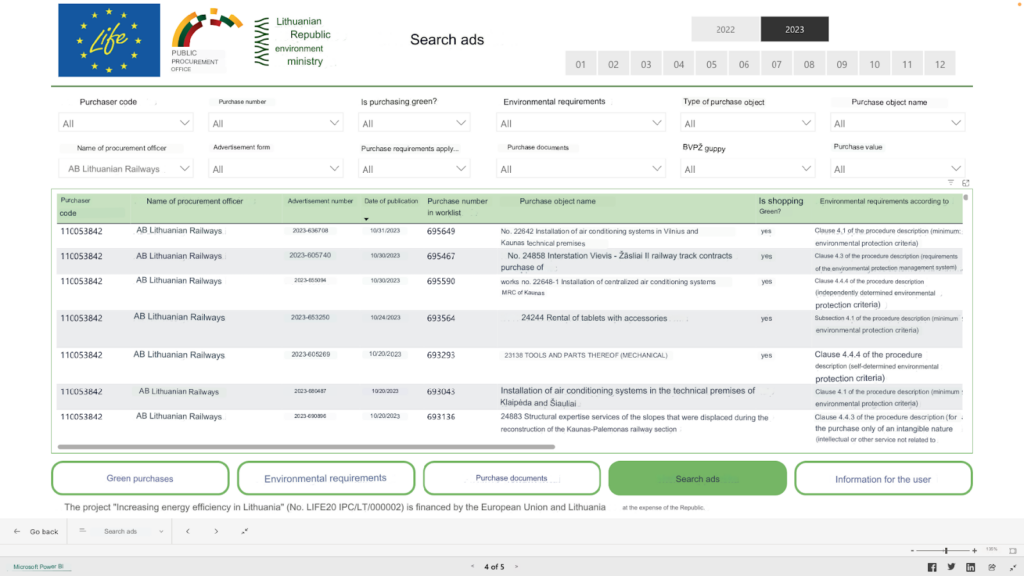
“This is a whole other level of granularity and depth of insight. We know exactly what’s going on with GPP in Lithuania and can offer even more nuanced assistance to contracting authorities based off that,” says Kęstutis Kazulis.
The LPPO is already exploring new opportunities to apply that data and technology, such as integrating life-cycle costing methodologies in the routine procedures of the e-procurement platform.
“The way we think about technology is that it has to help public buyers and suppliers conduct business easier. We want the system that, with the help of AI, helps buyers towards greener choices, that makes it easy to use life-cycle costing templates, and helps procurement leaders track and monitor the performance, and else,” says Marius Zemaitis, the Head of LPPO’s e-procurement department.
This is a whole other level of granularity and depth of insight. We know exactly what’s going on with GPP in Lithuania and can offer even more nuanced assistance to contracting authorities based off that.
Monitoring green impact
Lithuania is now planning the next big step in monitoring GPP – measuring the impact of GPP. The Ministry of Environment and Kaunas Technology University have been conducting GPP impact assessments to methodologies that could be institutionalized as routine monitoring.
Such research paves the way to establishing environmental metrics as a key performance indicator, along with existing indicators like financial savings or competition.
But collecting granular data is key, particularly about items procured and their specifications, to measure carbon dioxide emissions and consider the environmental footprint across their entire life-cycle.
“We are now discovering how important it is to have structured, granular procurement and other data to measure the impact of green procurement. We hope that our research will feed into changes needed to the data architecture to allow continuous GPP impact monitoring,” says Raminta Pucetaite, the head of the Public Governance research team at Kaunas Technology University.
Addressing the impact of climate change will need innovative solutions and out-of-the-box thinking. Lithuania has taken the first step and is pointing the way to what is possible with better and more granular data.
10 tips for implementing green procurement from Lithuania
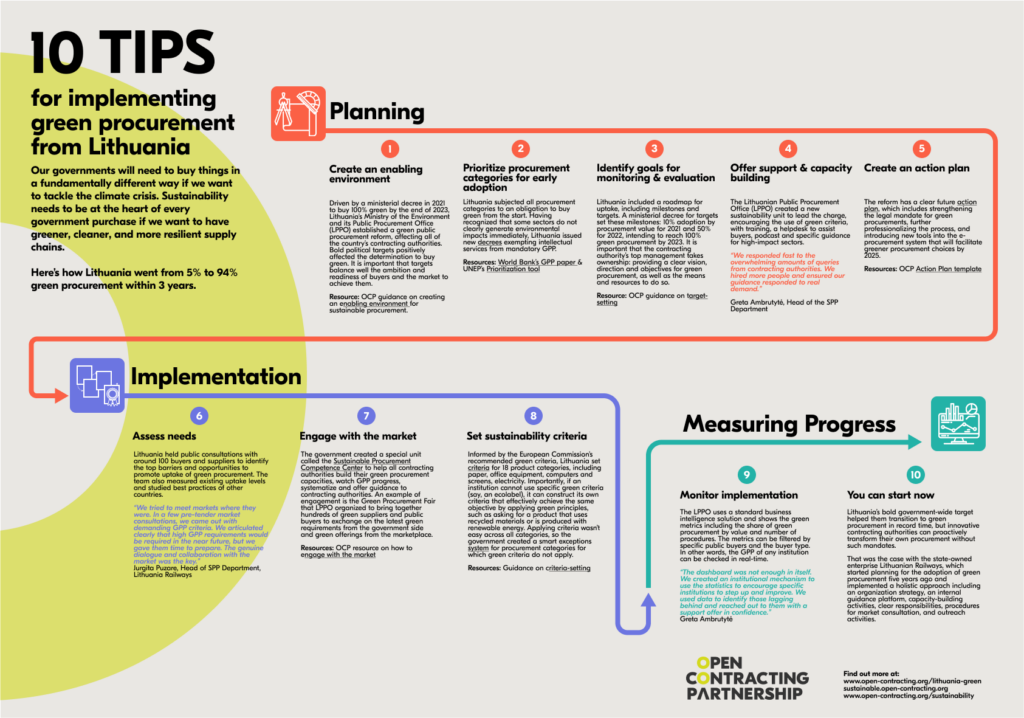
Planning
-
- Create an enabling environment
Mandated by the political decision to buy 100% green by the end of 2023, Lithuania’s Ministry of the Environment and its Public Procurement Office (LPPO) established a green public procurement reform by ministerial decree in 2021, affecting around 4,000 contracting authorities.
Bold political targets positively affected the determination to buy green as buyers had no choice but to comply. However, some say that it might have also encouraged the compliance-driven approach. “Many buyers tried really hard to comply with green requirements. In many instances, for example, intellectual services such as consultancy services, it was hard to do, so they created their own green criteria which sometimes looked like pro-forma requirements,” said Jurgita Puzare, Head of the Sustainable Public Procurement (SPP) Department at Lithuanian Railways. Therefore, it is important that targets balance well the ambition and readiness of buyers and the market to achieve them.
Resources: OCP’s guidance on evaluating and creating an enabling environment for sustainable procurement.
-
- Prioritize procurement categories for early adoption
Although existing global guidance recommends prioritizing categories for gradual uptake of GPP, Lithuania subjected all procurement categories to an obligation to buy green from the start.
“Subjecting all sectors to mandatory GPP wasn’t easy. We later had to change our legislation on the go and consider some sectors green by default, as they do not have environmental impact. We made it through and I recommend an ambitious approach, but I would also recommend considering exempting some sectors that you know will face difficulties and let them mature over time ”, says Kęstutis Kazulis.
Having recognized that some sectors do not clearly generate environmental impacts immediately, Lithuania issued new decrees exempting intellectual services from mandatory GPP.
Resources: There are two main global methodologies for sustainable procurement prioritization: World Bank’s GPP handbook and the Prioritization tool developed by the United Nations Environment Program (UNEP).
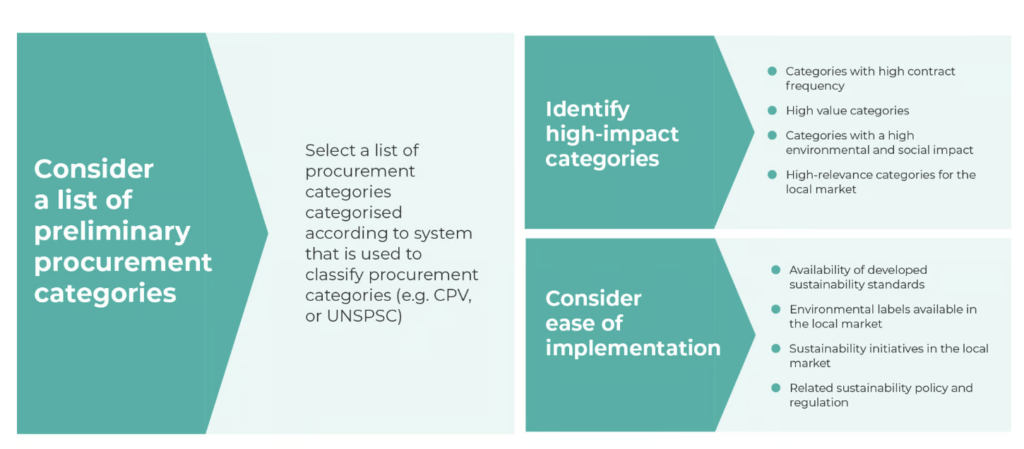
3. Identify goals for monitoring & evaluation
Lithuania included a roadmap for uptake, including milestones and targets. A separate Ministerial decree for targets set these milestones: 10% adoption by procurement value for 2021 and 50% for 2022, intending to reach 100% green procurement by 2023.

Greta Ambrutytė, the Head of the SPP Department at the Lithuanian Public Procurement Office now reflects that the target of 100% in less than three years, while it helped power through the reform quicker, caused some head-scratching for the public procurement specialists:
“100% was ambitious, and we’re on track. The increase in enquiries and advice from contracting authorities on green procurement is a good reflection of the ambition to achieve better results, but highlights the need for top managers to realize that the achievement of the GPP indicator is not only down to the involvement of the procurement professionals, but of the whole organization.
The GPP indicator itself is just a number to show how well contracting authorities are doing in achieving their sustainable procurement goals.
The support of a contracting authority’s top management for green procurement is a key factor in its success, so when strategizing ahead, it is important that the contracting authority’s top management takes ownership: providing a clear vision, direction and objectives for green procurement, as well as the means and resources to do so. I therefore recommend the development of a strategic plan for the contracting authority, which includes internal green procurement and sustainability objectives to be achieved by the contracting authority.”
Resources: Guidance on target-setting
4. Establish support and capacity-building mechanisms
The Lithuanian Public Procurement Office (LPPO) created a new sustainability unit to lead the charge, encouraging the use of green criteria, with training, a helpdesk to assist buyers, podcast and specific guidance for high-impact sectors. These activities are coordinated by the Sustainable Procurement Competence Centre, a special unit in the LPPO created by the Government in May 2021.
“We responded fast to the overwhelming amounts of queries from contracting authorities. We hired more people and ensured our guidance responded to real demand. We looked closely at the data about the uptake levels and responded with guidance for sectors that lag behind. The ability to track the real levels of GPP uptake by institutions made a huge difference in how we plan and work. I highly recommend setting robust reform tracking technology before taking any other steps. This is exactly what we are now doing with social procurement,” says Greta Ambrutytė.
Resources: Guidance on establishing a helpdesk and other support mechanisms
5. Create an action plan
The reform has a clear future action plan, which includes strengthening the legal mandate for green procurements, further professionalizing the process, and introducing new tools into the e-procurement system that will facilitate greener procurement choices by 2025.
Aurimas Saladžius, Head of Sustainable Development and Strategic Change Group at the Ministry of Environment says: “the action plan was very important, especially early on in its implementation, but the reason why it was successful was a combination of a very clear political commitment and financial and human resources for implementation, that allowed for creation of the SPP Competence Centre and digital tools. One without the other one would have been ineffective.”
Resources: Recommended template on how to create a sustainable procurement action plan
Implementation
6. Assess needs
Lithuania conducted a public consultation, speaking to around a hundred public buyers and procurement suppliers to understand what were the most pressing barriers and promising opportunities to promote the uptake of green procurement in the country. The survey showed 98% of contracting authorities cared about green procurement but only 10% thought it was easy to do.
The team also conducted a situation analysis and best practices of other countries to determine the current uptake levels and inspire the government to promote green procurement.
“We tried to meet markets where they were. In a few pre-tender market consultations, we came out with demanding GPP criteria. The market claimed to not be ready to satisfy them, so we had to compromise at first. We articulated clearly to the market that high GPP requirements would be required in the near future, but we gave them time to prepare. The genuine dialogue and collaboration with the market was the key ”, says Jurgita Puzare.
7. Engage with the market
The government created a special unit called the Sustainable Procurement Competence Center to help all contracting authorities build their green procurement capacities, watch GPP progress, systematize and offer guidance to contracting authorities.
An interesting example of engagement is the Green Procurement Fair that LPPO organized to bring together hundreds of green suppliers and public buyers to exchange on the latest green requirements from the government side and green offerings from the marketplace.
Green Procurement Fair Highlights
“We gathered buyers and suppliers in the heart of Vilnius, the City Hall, to encourage dialogue about green products and services, and discuss how to prepare for green procurement both by buyers and suppliers. Very instrumental for all,” said Kęstutis Kazulis of the LPPO.
Resources: How to engage with the market
8. Set sustainability criteria
Heavily informed by the European Commission’s recommended green criteria, Lithuania set criteria for 18 product categories, including paper, office equipment, computers and screens, electricity, etc. Importantly, if an institution cannot use specific green criteria (say, an ecolabel), it can construct its own criteria that effectively achieve the same objective by applying green principles, such as asking for a product that uses recycled materials or is produced with renewable energy. Applying criteria wasn’t easy across all categories, so the government created a smart exceptions system for procurement categories for which green criteria do not apply.
In addition to setting hard green criteria, government leaders reflect that it was useful to allow buyers/suppliers to create their own green criteria (with proof of equivalence attached) to enable them to adapt to real offers in markets. This allows suppliers to prove that their qualifications/certifications are equivalent to mandatory green criteria, avoiding unnecessary disqualifications.
Resources: Guidance on criteria-setting
Measuring Progress
9. Monitor implementation
The LPPO uses a standard Microsoft Business Intelligence (BI) solution and shows the following green metrics:
- The share (%) of green procurement by value of procurement
- The share (%) of green procurement by amount of procedures.
These metrics can be filtered by specific public buyers and the buyer type. In other words, it is possible to check the levels of GPP uptake by any institution in Lithuania at any point in time.
“The dashboard was not enough in itself. We created an institutional mechanism to use the statistics to encourage specific institutions to step up and improve. We used data to identify those lagging behind and reached out to them with a support offer in confidence. It also allows us to see the sectors that lag behind – we used that information to create sector-specific guidance and training,” says Greta Ambrutytė.
The Public Procurement Office added a set of key sustainability performance indicators to its procurement dashboard. Open reporting with clear institutional performance ratings has been used to incentivise adoption.
10. Don’t wait for permission to start
Lithuania’s bold government-wide target helped them transition to green procurement in record time, but innovative contracting authorities can proactively transform their own procurement without such mandates. That was the case with the state-owned enterprise Lithuanian Railways, which started planning for the adoption of green procurement five years ago.
The then-Head of Strategic Procurement at Lithuanian Railways, Jurgita Puzare says, “we knew the change was coming and, back in 2018 already, we put the green transition as our strategic goal. We were even more ambitious than the government aiming to have 100% of green procurement from 2022. We used the LPPO dashboard to track the progress.”
Lithuanian Railways (also known as LTG) took a holistic approach to green procurement with the following measures:
- An organization strategy that clearly puts environmental sustainability as a strategic objective with a commitment to reduce carbon dioxide emissions
- An internal platform of guidance with relevant information about GPP, links to legal provisions and their interpretation, FAQs, and other training materials
- Regular capacity building activities for its staff to procure green
- A staff member responsible for GPP who constantly learns about the field and is in charge of staff capacity building, but also external collaboration, including consulting the Ministry of Environment and other public buyers
- Flexible procedures for market consultation, paying lots of attention to ensuring its tenders are relevant and realistic for market participants to bid
- Outreach and branding activities, such as “Going Green” campaigns encouraging passengers to choose CO2-free modes of transport and clearly outlining how LTG contributes to the European Green Deal. For example, LTG reports that the value of public procurement of the rolling stock is more than €200 million. The renewal of the train fleet is estimated to reduce carbon dioxide emissions by 69% per year.
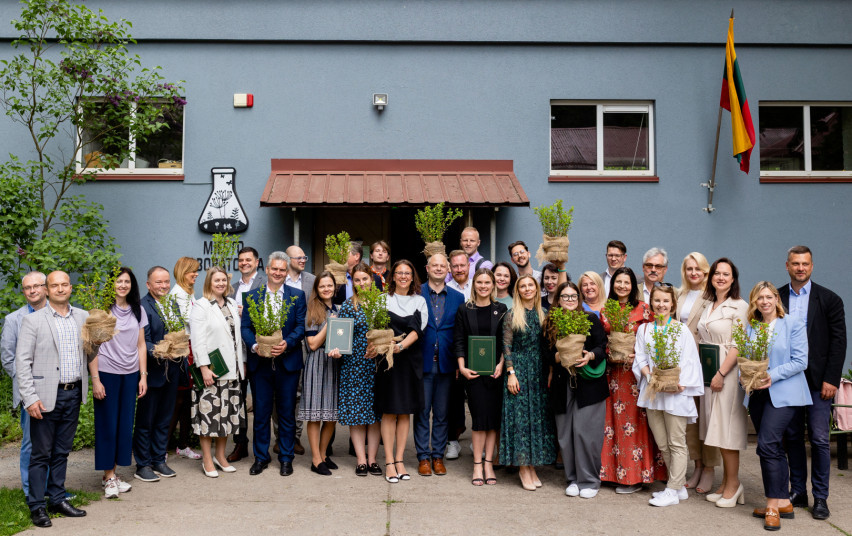
In 2022, LTG received a green procurement leadership award from the Ministry of Environment, in its capacity as both a government buyer and supplier. It was also recognized as a “sustainable brand” by the Sustainable Brand Index.